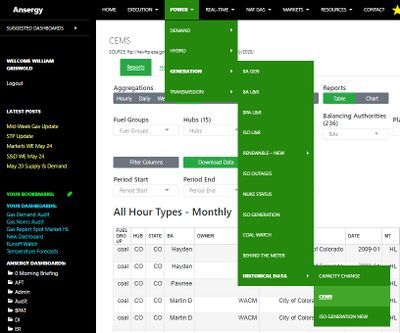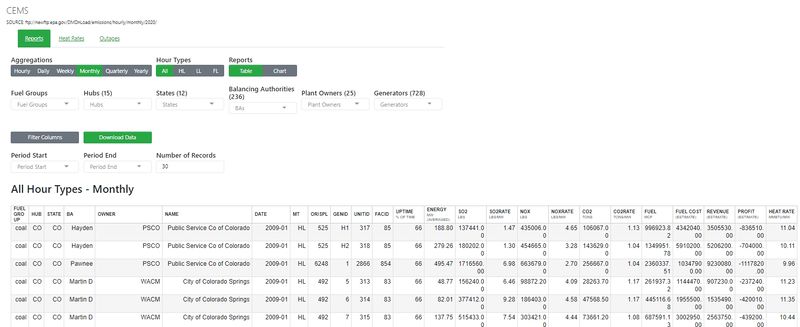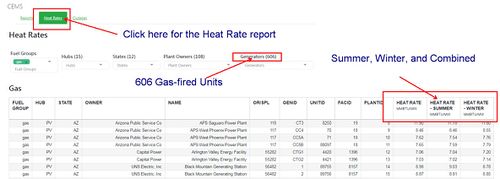Difference between revisions of "CEMS"
(Created page with "== Where == [https://wp.ansergy.com/cems/#/reports/ Main Menu / Power / Generation / Historical Data / CEMS] alt=Menu Location|400x400px =...") |
(→Where) |
||
| Line 3: | Line 3: | ||
| − | [[File: | + | [[File:CEMS Menu.jpg|alt=Menu Location|400x400px]] |
= What = | = What = | ||
| − | + | The EPA (Environmental Protection Agency) provides Continuous Emissions Monitors (CEMS) data publicly. Ansergy captures this data and presents it in an easy to read format. | |
| − | |||
| − | |||
| − | + | CEMS is EPA’s power plant database of hourly data and includes the following unit-level data: | |
| − | |||
| − | + | * History – full hourly starting on January 1, 2009 through March 31, 2019. EPA updates CEMS once a quarter, about 30 days following the expiry of the Q. | |
| + | * Energy – hourly MWH by generating unit; our WECC CEMS has 680 coal and gas-fired units reflecting around 60,000 MWs of capacity. | ||
| + | * Fuel Burn – both hourly coal and gas burn measured in MMBtu. | ||
| + | * Emissions – SOX, NOX, and CO2 | ||
| + | * Rates – SOX/MWh, NOX/MWh, CO2/MWh | ||
| + | * Heat Rates | ||
| − | + | [[File:CEMS Table.jpg|alt=Table Depiction|none|thumb|800x800px|Table Depiction]] | |
| − | + | ||
| − | + | == Report Types == | |
| − | + | ||
| − | + | === Heat Rates === | |
| − | + | [[File:CEMS Heat Rate.jpg|500x500px]] | |
| − | + | ||
| − | + | CEMS is the only source for actual heat rates. Ansergy has made it easy to pull these with its canned heat rate report. With a click, you can see summer, winter, or melded heat rates computed from actual gas burn and generation since 2009. You can also derive other heat rates like Ramp Up heat rates. | |
| − | + | ||
| − | + | === Outages === | |
| − | + | [[File:CEMS Outages.jpg|alt=CEMS Outages|500x500px]] | |
| − | + | ||
| − | + | ||
| − | + | Another energy mystery are outages; only the NERC and the plant owners have the true outages … and users of CEMS. Ansergy has compiled lists of all unit outages greater than 2 Days. | |
| + | |||
| + | In the above example, we filtered out the coal units and get a list of every outage greater than 2 days since 2009. Look for repetitive outages of similar duration to back into planned outages, or compute your own forced outage rates. | ||
| + | |||
| + | === CEMS Emissions === | ||
| + | [[File:CEMS Emissions.jpg|alt=CEMS Emissions|500x500px]] | ||
| + | |||
| + | |||
| + | Each unit returns its hourly SOX, NOX, and CO2. You can then compile emission rates either by fuel (MMBTU) or energy (MWH). In the above example, California SOX, NOX, and CO2 are plotted and aggregated by month for the HL hours. Use the standard charting filters to make changes. | ||
== Related Reports == | == Related Reports == | ||
| Line 36: | Line 46: | ||
* EIA 861M Detail | * EIA 861M Detail | ||
* Capacity Change | * Capacity Change | ||
| + | * CEMS | ||
== | == | ||
Latest revision as of 11:06, 26 May 2021
Where
Main Menu / Power / Generation / Historical Data / CEMS
What
The EPA (Environmental Protection Agency) provides Continuous Emissions Monitors (CEMS) data publicly. Ansergy captures this data and presents it in an easy to read format.
CEMS is EPA’s power plant database of hourly data and includes the following unit-level data:
- History – full hourly starting on January 1, 2009 through March 31, 2019. EPA updates CEMS once a quarter, about 30 days following the expiry of the Q.
- Energy – hourly MWH by generating unit; our WECC CEMS has 680 coal and gas-fired units reflecting around 60,000 MWs of capacity.
- Fuel Burn – both hourly coal and gas burn measured in MMBtu.
- Emissions – SOX, NOX, and CO2
- Rates – SOX/MWh, NOX/MWh, CO2/MWh
- Heat Rates
Report Types
Heat Rates
CEMS is the only source for actual heat rates. Ansergy has made it easy to pull these with its canned heat rate report. With a click, you can see summer, winter, or melded heat rates computed from actual gas burn and generation since 2009. You can also derive other heat rates like Ramp Up heat rates.
Outages
Another energy mystery are outages; only the NERC and the plant owners have the true outages … and users of CEMS. Ansergy has compiled lists of all unit outages greater than 2 Days.
In the above example, we filtered out the coal units and get a list of every outage greater than 2 days since 2009. Look for repetitive outages of similar duration to back into planned outages, or compute your own forced outage rates.
CEMS Emissions
Each unit returns its hourly SOX, NOX, and CO2. You can then compile emission rates either by fuel (MMBTU) or energy (MWH). In the above example, California SOX, NOX, and CO2 are plotted and aggregated by month for the HL hours. Use the standard charting filters to make changes.
Related Reports
- EIA 861M (Behind the Meter)
- EIA 861M Detail
- Capacity Change
- CEMS
==




